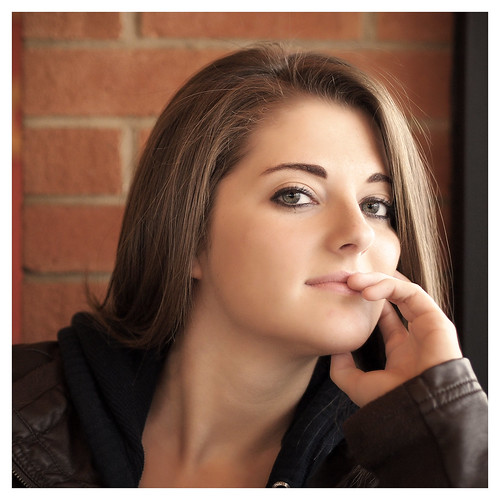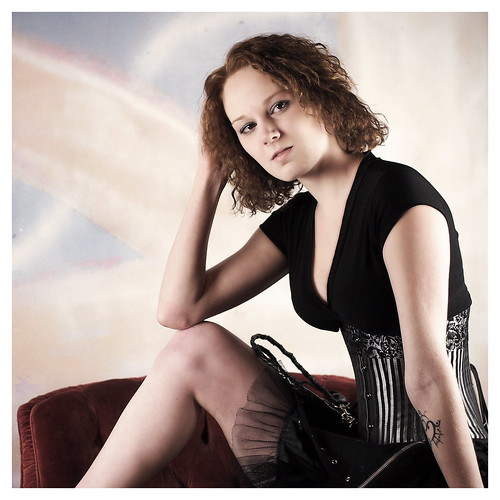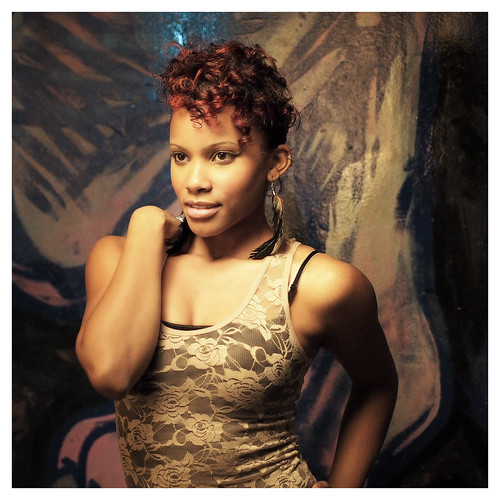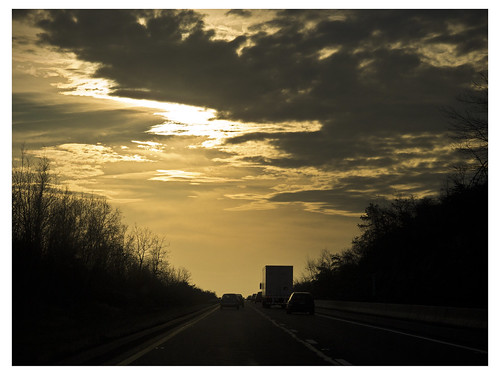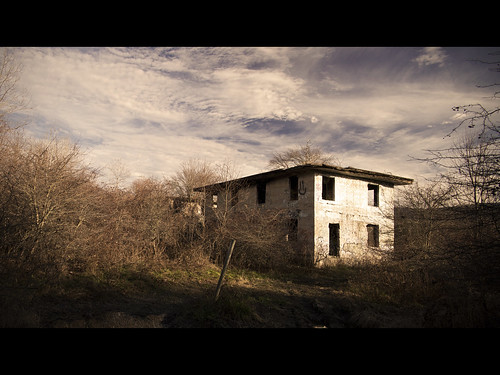This past weekend saw me engaged in the kind of shooting that deep down I've always (and will always) yearned to do for a living. Candid portraiture. Studio portraiture. High fashion. Makeup. Glamor. Beauty. Those things that the photography industry rode on so easily in the 80s, hit a plateau on in the 90s and then lost monopoly on completely in the 00s. Not that I cared. I wasn't in the thick of this world of pretty girls and dramatic vibes to make money. Hell, I wasn't really so much there to make friends (barring Friday's shoot with Allyson, featured to the right here... but she was already a friend so that hardly counts). I dunked my core into this world to discover whether or not it really, truly, honestly bore the satisfaction I would demand from it should I stake the bread and butter of my business plan on its practice (a business plan which is complete, by the way, and currently undergoing scrutiny and polishing by several third parties). The vigor and adrenal rush of the portrait shoot was already apparent, but would it stand up to the required structure and uniformity necessary to function from a business standpoint?
The short answer is "Holy Shit Yes" (and yes, indeed, that is the shortest possible answer, period). I'll start with Friday.
As is my typical working Friday, I was due to be off work by the early afternoon. And, again, as is typical for my working Fridays, I intended to capitalize on available daylight and go photograph... something. Originally my plan was to slip into abandoned building X and photograph my typical decay and detritus, and in hunting for a partner in crime I quietly posted a casting call for company on the adventure. Instead, I was accosted by Allyson, a girl I'd grown up with in high school, a most lovely young lady with high wit and incredible intelligence, a standalone in the crowd (from which I collected more than a few standalone friends of similar caliber). For some time earlier in the year she'd discussed wanting to serve as a candid model for me, but with her working 2 jobs and myself being horribly unavailable and spontaneous in my dealings, schedules never aligned and we never managed to get together for a shoot. This particular Friday, however, planets aligned, and so we agreed to meet at Starbucks for coffee, catchup and cameras.
It had been nearly 7 years since we last saw each other, so the initial passing of life stories was of course in order. More than that, however, this introductory phase served as an easy mode test bed for a critical part of my business plan which emphasizes not passing through clients rapidly, but rather developing a comfortable, familiar relationship with the client first, something which is both conducive to the portrait shoot itself by merit of making the process feel casual and natural, but opens up future opportunity to work with the client again as a preferred photographer. Now, of course, working with Allyson was easier than trying the same with a complete stranger given our history, but with enough time having passed since our last face to face the need was still there to break into that zone of comfort prior to the engagement of the portrait shoot. And it worked out famously. We spoke of her college time, her plans in life of saving money and buying a house, family and relationship situations... we quickly made our way to frank, honest confessions to one another, and that is the critical point at which a portrait shoot has the utmost potential to ascend into genuine art, not simply forced expression.
I popped the lens cap off and started snapping. The conversation continued (as it should), but because we took the time to communicate and trust each others' intentions we synched onto this abstract wavelength I always strive to achieve with my portrait subjects. Although we were still talking, still engaging in business as usual, through a combination of conversational cadence and body language we communicated when the moment was right for a photo, and she would pick up on my subtle cues immediately and freeze whatever position, direction of eyesight, expression, what have you, and wait for me to take the snap, all of which occurring in a matter of milliseconds. I easily snapped 200 plus frames of Allyson while we talked over coffee at Starbucks, and only but a few times, less than could be counted on one hand, did timing and mental communion falter and lead to a silly eyes-half-closed false frame.
To date I've only worked with perhaps a half dozen models who've connected on such a pertinent mental wavelength. Granted, most of the time, I don't go out of my way to establish that communion of mental states, however Allyson would be the first person I've ever attempted to establish that connection with very deliberately, and seeing the fruits of our collaboration in this portrait session, it is without a doubt the most critical facet to the success of an artistically considered portrait shoot. To that end, I thank Allyson for our session last Friday if for no other reason than for opening up that critical insight via hard, deliberate testing (although the portraits themselves are exceptionally gorgeous too, gotta say).
With our session concluded only due to a dying camera battery, we parted ways and enjoyed the rest of our evenings in our own respective fashion. We are, however, bearing all intent of working together again, an on-location shoot preferred by both parties. Aside from being another opportunity to photograph a lovely girl, that shoot would serve as a test for another aspect of the provided services in my business plan. Hopefully I'll have some competent studio lighting equipment to utilize by the time the weather outside is slightly less frightful. Anyway...
... Then Saturday happened.
Ren Garczynski, purveyor of Random Eye Candy Photography and owner of dedicated studio space at Baltimore's Graffiti Warehouse, a very, well, "Baltimorian" art studio venue that encourages rampant graffiti murals and all levels of high glamor studio photography, invited me to attend their holiday open house. The premise was simple enough - $20 for photographers, $5 for models, pay your way in and you have 6 hours in which to link up with models, utilize community backdrops, props and portrait lights, and go to town creating vogue photographic art. I walked into the place Saturday afternoon expecting a collection of the lost and confused wandering around afraid to mingle and network. Whew, was I wrong... instead I walked into a party.
Right from the get go, after paying into the main vestibule I stepped into a room crowded with makeup artists, costumers, models and photographers, everyone at work experimenting with the most random and often nonsensical combinations of light and style imaginable. And it worked every time. Very often the process was model driven - instead of the photographer leading the model in a certain way, the model would select props and backdrops and a flood of up to a dozen different photographers would gravitate around her (well, I suppose there were a few "hims" in the modeling roster, but really, let's be honest, they were predominantly "hers"). It was a few levels of insane, augmented by live electronic music being mixed on the spot by a 3 DJ crew which cycled interchangeably. Nonsense in tandem that somehow functioned without a hitch.
One element really stood at the forefront of the separation of myself from all other photographers there, however. I would venture to guess that easily 90% of the photographers around me were shooting models with kit zooms, amateur (by which I mean sub-$1000) CaNikon DSLR bodies and direct, occasionally diffused shoe mounted flashes. In other words, the standardized, homogenous setup "expected" of all "serious" photographers. Meanwhile, I'm happily strutting along with my Micro Four Thirds Olympus E-P3 with a fast prime 45mm f/1.8 mounted on the front and no viewfinder to speak of barring a rear OLED LCD screen. It could be argued that I was the venue's iconic minimalist. And as hipster of me as it is to feel a sense of pride in that status... I don't know, I think my results with such minimalist gear stand up well on their own.
While most photographers never touched the constant lights available to them, I couldn't stop screwing around with them, and I found 2 in particular that I very much liked and would love to add to my equipment list some time. A pair of 8-bulb compact fluorescent soft boxes that put off the most spectacular light as they heated up. When a photographer insisted upon utilizing a strobe, I used nothing more than the constant preview light they emitted, not once synching to a strobe because... why? I had all the light I needed, and by god was it soft and smooth and gorgeous. A couple times, while using the constant lights, photographers insistent upon using nothing more than their directly aimed, off-branded, non-metered flashes would demand I take the hot lights off the model because their impact on the frame caused their exposures to be blown out, to which I typically responded "Then dial down your exposure or turn off your flash". Unfortunately, not a single person I imparted this suggestion onto took it at all because, of all the hilarious things, very few photographers there knew how to meter on their own, completely dependent on either the Auto setting or Program for everything. Manual EV adjustments be damned, I suppose.
Complaints aside, the venue was absolutely fantastic, however I felt it too overcrowded just 2 hours in and resigned myself from shooting to simply spend time seeing the talented Ren at work in her private studio with a model and friend who I've photographed before, Kyle. The pair were engaged in a Mr. Winter themed portrait shoot, with Kyle covered in white body makeup and whitening hair spray. Her results were very cool (double entendre not withstanding). All in all a very good day and very good experience, and at least a partial foray into the world of high fashion/glamor/model photography that I also hope to implement in my business should I ever manage to network my way into it. For years I complained of how little time spent at college meant to ones skill as a photographer, but more and more I'm coming to realize the investment in college for artists is never, EVER about acquiring new knowledge and applying new technique, it is all about meeting people, gaining exposure, assembling the right portfolio and attaining the required recognition to more or less "buy" your way into the world of high art photography. And to think I had it all wrong all those years.
Perhaps it's time to take some courses...
Wednesday, December 21, 2011
Thursday, December 1, 2011
When Does a Snapshot Become Art?
Go ahead and laugh at the question if you must.
Photography, and what defines a photo of artistic-grade aesthetic value, is both fickle and maddeningly nebulous. It is the nature of a non-quantitative thing to be impossibly abstract and reluctant to be weighted down by something so mundane as "definition". Thus the selection process I employ when sifting through my photographs for the "keepers" buried amongst the snaps is... difficult.
My habits when sitting down at the computer at the end of a day of shooting are predictable and brutally consistent. Rip the photos onto the hard drive, pop open Adobe Bridge and peek through them one by one. What is horribly inconsistent, however, is what exactly I'm looking for. The night of a shoot I will have in my mind exactly what I'm excited to review and edit in post, the compositions I stopped to think out carefully on a venture with the direct intent to produce art. Eager to share them, I will punch through editing in a couple hours of miserable repetition and upload them to Flickr, distribute them into groups and sit back with the giddy "Look at me and what I did" anticipation of a toddler.
But then there's a phase that creeps up after.
Not every photograph I take is meticulously considered. A great many of my captures hearken directly to my namesake. Knee-jerk images. Moments come and go without stopping, there is rarely a second chance and if the moment is not quickly taken advantage of it will pass on and be forgotten just as quickly as it cropped up in the first place. Snapshots. Candid moments that can embody a vivid memory that would otherwise be completely discarded by what our brains will allow us to recollect.
Now, they aren't always pretty. Such fleeting moments require sloppy spur of the moment reaction, and the attempt to capture that moment isn't necessarily success. But if you're quick enough, if the planets align in that moment and the light is right and the camera is set and the camera is trained on the scene, sometimes that moment is captured beautifully. BUT, assuming the occurrence of a miracle allowed that passing moment to be captured, that memory photographically recorded... is it art?
In my foolish efforts to apply a quantitative definition to what defined a photograph as artwork, I have assembled a set of rules by which an image must abide before I consider it as artwork. The exposure must be balanced, not too dark, not too light. Focus must be spot on and the image must be marked by tack sharpness. Verticals and horizontals must be meticulously aligned and considered. Faces must have some specific expressions or elements of appeal. A million considerations which result in a mass casting out of images from my consideration. I've found a trick, though... a segue into loosened rules, lowered defenses and less process oriented, whimsical thinking.
I sit down with a couple glasses of vodka/rum/whiskey/what have you. Magic happens.
My vision and coordination are woefully stunted and suddenly things that my active conscious rejected outright before are met with consideration as my subconscious takes over. Those rigid, defined images that involved prudent planning and compositional assembly fall by the wayside, they are silly things only an engineer could love. Instead, I look at the snaps. I look at faces and skies and isolated subjects and melting focus and I find things with an undefinable appeal. Pop them into Photoshop and drunkenly give them a muscle memory touch up, post them to be shared, and only the next morning do I realize what I've done.
Not even my active conscious can deny them consideration anymore. I see relationships and shapes and lines and colors and tones and expressions and suddenly they are the most beautiful images I've ever seen, often embodying memories I'd cast aside for sake of the pursuit of "higher art". And in those moments I wonder what it is that defines the art-value to begin with. There are two sides to me, both with grossly different appeals but due appreciation for each other. The sobered, rigid, detail oriented clear mind and this spontaneous, flimsy yet emotionally intuitive mind. Which one is the artist here? And under what instinct does a snapshot meet the standards of "art" to this subconscious drive?
The answer is elusive. Maybe I need a drink to find it.
Photography, and what defines a photo of artistic-grade aesthetic value, is both fickle and maddeningly nebulous. It is the nature of a non-quantitative thing to be impossibly abstract and reluctant to be weighted down by something so mundane as "definition". Thus the selection process I employ when sifting through my photographs for the "keepers" buried amongst the snaps is... difficult.
My habits when sitting down at the computer at the end of a day of shooting are predictable and brutally consistent. Rip the photos onto the hard drive, pop open Adobe Bridge and peek through them one by one. What is horribly inconsistent, however, is what exactly I'm looking for. The night of a shoot I will have in my mind exactly what I'm excited to review and edit in post, the compositions I stopped to think out carefully on a venture with the direct intent to produce art. Eager to share them, I will punch through editing in a couple hours of miserable repetition and upload them to Flickr, distribute them into groups and sit back with the giddy "Look at me and what I did" anticipation of a toddler.
But then there's a phase that creeps up after.
Not every photograph I take is meticulously considered. A great many of my captures hearken directly to my namesake. Knee-jerk images. Moments come and go without stopping, there is rarely a second chance and if the moment is not quickly taken advantage of it will pass on and be forgotten just as quickly as it cropped up in the first place. Snapshots. Candid moments that can embody a vivid memory that would otherwise be completely discarded by what our brains will allow us to recollect.
Now, they aren't always pretty. Such fleeting moments require sloppy spur of the moment reaction, and the attempt to capture that moment isn't necessarily success. But if you're quick enough, if the planets align in that moment and the light is right and the camera is set and the camera is trained on the scene, sometimes that moment is captured beautifully. BUT, assuming the occurrence of a miracle allowed that passing moment to be captured, that memory photographically recorded... is it art?
In my foolish efforts to apply a quantitative definition to what defined a photograph as artwork, I have assembled a set of rules by which an image must abide before I consider it as artwork. The exposure must be balanced, not too dark, not too light. Focus must be spot on and the image must be marked by tack sharpness. Verticals and horizontals must be meticulously aligned and considered. Faces must have some specific expressions or elements of appeal. A million considerations which result in a mass casting out of images from my consideration. I've found a trick, though... a segue into loosened rules, lowered defenses and less process oriented, whimsical thinking.
I sit down with a couple glasses of vodka/rum/whiskey/what have you. Magic happens.
My vision and coordination are woefully stunted and suddenly things that my active conscious rejected outright before are met with consideration as my subconscious takes over. Those rigid, defined images that involved prudent planning and compositional assembly fall by the wayside, they are silly things only an engineer could love. Instead, I look at the snaps. I look at faces and skies and isolated subjects and melting focus and I find things with an undefinable appeal. Pop them into Photoshop and drunkenly give them a muscle memory touch up, post them to be shared, and only the next morning do I realize what I've done.
Not even my active conscious can deny them consideration anymore. I see relationships and shapes and lines and colors and tones and expressions and suddenly they are the most beautiful images I've ever seen, often embodying memories I'd cast aside for sake of the pursuit of "higher art". And in those moments I wonder what it is that defines the art-value to begin with. There are two sides to me, both with grossly different appeals but due appreciation for each other. The sobered, rigid, detail oriented clear mind and this spontaneous, flimsy yet emotionally intuitive mind. Which one is the artist here? And under what instinct does a snapshot meet the standards of "art" to this subconscious drive?
The answer is elusive. Maybe I need a drink to find it.
A Filter is Fine Too
This past weekend saw a fun, photography filled road trip through what I and those I was photographing with endearingly refer to as "Coal Country". A one day trip, half of which total likely having taken place in the cramped space of a car, cruising through rolling hills coated in dead and albino-bleached trees. The ensuing back pain was well worth it.
We met up early in the morning, on the brink of twilight just before sunrise would blanket the landscape with golden light. Our itinerary had only one specific location set firmly in stone, the rest of the trip being much more wishy-washy and open to spur of the moment ideas. Though an enjoyable and very much fruitful venture, I find myself wanting to take it again on the sooner rather than the later. It felt like a dry run, a first impression of the subject, and with knowledge now of what works and what doesn't, the second trip would be an assured tapping into a photographic gold mine.
On the subject of the "what works" elements I discovered in my dry run shooting, I actually tapped into something of a lost art that benefited my exterior shooting especially. Back when I was still sitting squarely in the Nikon camp (good lord, am I glad I'm done with those days of brand elitism), filter use seemed like an obvious route to go down. I was still in the habit of applying UV filters to all my lenses (again, so glad I'm not longer following antiquated practices), and every time I'd run to Ritz to pick up a new multi-coated piece of crappy glass I'd see what else was in their 52mm filter stock. My filter collection was pretty considerable by the time I realized I was never using the damn things, laden with starbursts and diffuse and neutral densities and polarizers. Ridiculous. Except for two - the NDs and the polarizers.
Though their function was clear as ever in my brain, their use seemed grossly unnecessary once the habit of shooting RAW became standard practice. At the time, nearly everything I shot with a filter saw the filter's effect negated by the tendencies of RAW processing. They had effect when shooting JPG, but there was no point to JPG shooting with Panasonic's lackluster rendering engine. Enough curiosity gripped me the morning of the trip that I grabbed the polarizer and ND before stepping out the door. Holy crap, am I glad curiosity bit.
How I could forget how gorgeously polarizer use affects skies is beyond me. The effect is simply delicious, and with on-board bias of white balance favoring the warm, the exposures didn't suffer the ugly blue cast typical of all Quantaray filters (the cheapest of the cheap). Sharpness was unaffected because I wasn't forcing an image through a UV prior to the polarizer like I had done for years on my Nikon equipment (seriously, if you're using a UV, TAKE IT OFF). The skies, my god, the skies... they just looked... GOOD.
Though slightly less effective, the ND was another missed item in the bag. The joy of fast primes is the creamy bokeh and limit of area in focus when the aperture is able to keep wide open. In broad daylight, this is obviously not reasonable. However, slap that 2-stop ND on the lens and suddenly daylight shots are as creamy delicious as you'd ever want them to be. Again, with the E-P3's built-in A2 bias, the blue cast typical of Ritz's cheap filter glass wasn't an issue. Lovely!
Some time down the road I would do well to purchase a polarizer and ND set from a more respectable filter maker, B&W of maybe Tiffen. But in the mean time, I'll deal with on-camera filter fault correction.
We met up early in the morning, on the brink of twilight just before sunrise would blanket the landscape with golden light. Our itinerary had only one specific location set firmly in stone, the rest of the trip being much more wishy-washy and open to spur of the moment ideas. Though an enjoyable and very much fruitful venture, I find myself wanting to take it again on the sooner rather than the later. It felt like a dry run, a first impression of the subject, and with knowledge now of what works and what doesn't, the second trip would be an assured tapping into a photographic gold mine.
On the subject of the "what works" elements I discovered in my dry run shooting, I actually tapped into something of a lost art that benefited my exterior shooting especially. Back when I was still sitting squarely in the Nikon camp (good lord, am I glad I'm done with those days of brand elitism), filter use seemed like an obvious route to go down. I was still in the habit of applying UV filters to all my lenses (again, so glad I'm not longer following antiquated practices), and every time I'd run to Ritz to pick up a new multi-coated piece of crappy glass I'd see what else was in their 52mm filter stock. My filter collection was pretty considerable by the time I realized I was never using the damn things, laden with starbursts and diffuse and neutral densities and polarizers. Ridiculous. Except for two - the NDs and the polarizers.
Though their function was clear as ever in my brain, their use seemed grossly unnecessary once the habit of shooting RAW became standard practice. At the time, nearly everything I shot with a filter saw the filter's effect negated by the tendencies of RAW processing. They had effect when shooting JPG, but there was no point to JPG shooting with Panasonic's lackluster rendering engine. Enough curiosity gripped me the morning of the trip that I grabbed the polarizer and ND before stepping out the door. Holy crap, am I glad curiosity bit.
How I could forget how gorgeously polarizer use affects skies is beyond me. The effect is simply delicious, and with on-board bias of white balance favoring the warm, the exposures didn't suffer the ugly blue cast typical of all Quantaray filters (the cheapest of the cheap). Sharpness was unaffected because I wasn't forcing an image through a UV prior to the polarizer like I had done for years on my Nikon equipment (seriously, if you're using a UV, TAKE IT OFF). The skies, my god, the skies... they just looked... GOOD.
Though slightly less effective, the ND was another missed item in the bag. The joy of fast primes is the creamy bokeh and limit of area in focus when the aperture is able to keep wide open. In broad daylight, this is obviously not reasonable. However, slap that 2-stop ND on the lens and suddenly daylight shots are as creamy delicious as you'd ever want them to be. Again, with the E-P3's built-in A2 bias, the blue cast typical of Ritz's cheap filter glass wasn't an issue. Lovely!
Some time down the road I would do well to purchase a polarizer and ND set from a more respectable filter maker, B&W of maybe Tiffen. But in the mean time, I'll deal with on-camera filter fault correction.
Subscribe to:
Posts (Atom)

